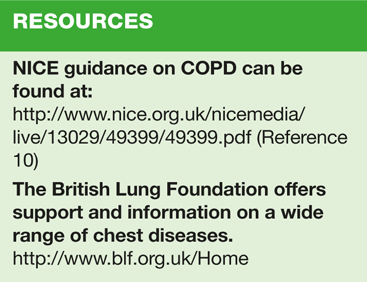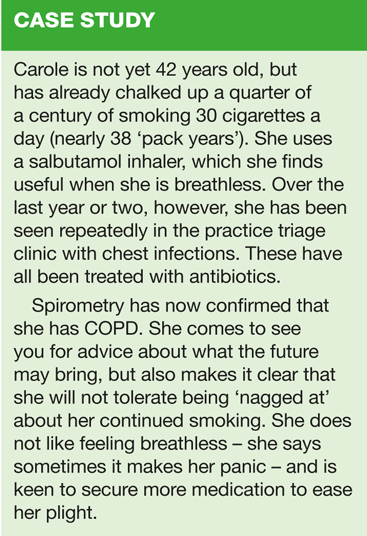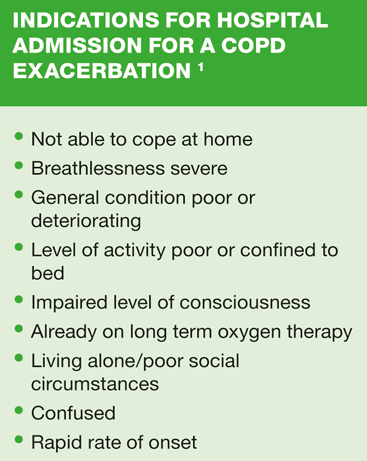When to use steroids in COPD
Dr Ed Warren FRCGP
Dr Ed Warren FRCGP
GP in Sheffield, Trainer Barnsley VTS
Where breathlessness in a person with COPD is persistent then inhaled corticosteroids (ICS) are often prescribed. This is not always appropriate and there are now clear, evidence based, guidelines on when they should be offered
Chronic Obstructive Pulmonary Disease (COPD) is the preferred term for conditions previously known as chronic bronchitis, emphysema, chronic obstructive airways disease and chronic airways limitation.1 It is characterised by limitation of airflow which is largely irreversible, a major difference from asthma (with which COPD is frequently confused) where the obstruction is largely reversible.1
According to the Healthcare Commission there are about 3 million people in the UK with COPD, but two thirds of them don't know that they have it.2 QOF data suggests a diagnosed prevalence of 1.6%.3 COPD is strongly associated with socio-economic deprivation and its prevalence varies with area (lowest in London, highest in the North East). Prevalence also increases with age and urban living so that the prevalence is 10% in people aged 60-75 who live in a rural area, but can be as high as 26% in people who live in an urban area.4 However, a recent, international survey5 has demonstrated the immense impact of COPD on working age populations. Apart from a universal reduction of quality of life COPD forces 40% of 45-67 year olds with the condition to retire early, and 22% of these individuals require care on a daily basis. In advanced COPD, over 80% of patients are house-bound, and over a third are confined to a chair.6 In an average practice of 7,000 patients, there will be about 200 people with COPD who will consult, on average, 2.4 times a year; amounting to more than 400 consultations a year.2
COPD is the reason for about one in eight of all medical hospital admissions.7 It has been estimated that up to 25% of those admitted to hospital because of an acute exacerbation of COPD will be dead within a year.8 COPD costs the NHS £270m a year in medication and £310m a year in hospital admissions. In addition COPD is responsible for £2.7bn in lost productivity each year.3
COPD kills 26,000 people a year in England and Wales, among the highest death rate in Europe, and the number of deaths continues to rise.9 Currently 5.6% of all male deaths and 3.9% of all female deaths are attributable to COPD.
COPD is associated with an abnormal inflammatory response of the lungs to noxious particles or gases.10 In at least 85% of cases the noxious substance involved is cigarette smoke.1 Since only between 10% and 25% of smokers develop COPD a genetic predisposition may also be a factor.10 Reducing, and preferably stopping smoking is a fundamental aspect of COPD management since this is, to date, the only intervention known to slow down the rate of lung function decline. However, since damage has already occurred, once COPD has been diagnosed medication is also required.
TREATING COPD
Carole uses salbutamol intermittently. This is recommended by NICE as appropriate therapy for people with COPD who suffer from breathlessness and/or whose activity is limited by the disease.1 Salbutamol is a short acting beta-2 agonist (SABA) that works by temporarily relaxing the muscles round the airways, thus allowing more air through. The effect is achieved rapidly, within a few minutes, but is short lived; after 4 hours a repeat dose may be needed.
A similar effect to a SABA can also be achieved with the short acting muscarinic antagonist (SAMA), ipratropium. SABA are best given via the inhaled route. SAMA are only available in this formulation. They are most commonly given via a Metered Dose Inhaler (MDI) which gives a fixed dose with each activation so that doses can be specified as a number of 'puffs' on the inhaler. For example, a typical dose regime for salbutamol in Carole's case would be 2 puffs as necessary, each puff delivering 100 micrograms of drug.
Using an MDI alone is tricky and needs training and practice to get right. Some people never learn to use one correctly. Once learned it is important that inhaler technique is checked periodically because many patients will lapse into bad habits over time. The effectiveness and ease of use of an MDI can be increased significantly by the use of a spacer. Spacers reduce the need for co-ordination of actuation of the inhaler and inhalation, slows down the speed of the inhalation so that less just hits the back of the throat - reducing the risk of oral thrush when used with a steroid inhaler - and makes the drug-taking process rather simpler. The bigger spacers work better, but are more bulky and difficult to carry around. There are a number of smaller spacers available on prescription, which may be useful for patients who wish, and are able, to get out and about.
Nebulisers used to be very popular for the treatment of COPD, and are still used in hospitals for acute exacerbations. This can present a problem in primary care. The nebuliser is a piece of technology that may be perceived as 'high tech', associated with the medicine that goes on in hospitals. Some people with COPD will think they are therefore the 'best' and want one at home.
A nebuliser is simply a way of delivering a large dose of drug (typically equivalent to 25 to 50 puffs of a salbutamol MDI), but is, in fact, a very inefficient and expensive way of delivering medication. Only around 10% of drug gets into the lungs,11 which is worse than a properly used MDI alone and much worse than MDI plus spacer. A nebuliser can be life-saving in an acute exacerbation of COPD when the individual is acutely breathless, but should only be considered for long-term, maintenance use when all other strategies for management have failed and only after specialist assessment.1 Nebulisers cannot be prescribed in England or Wales (but are free of VAT liability) but can be prescribed in Scotland.
Next steps for Carole
At the moment Carole is symptomatically controlled with just her salbutamol inhaler. However, she still finds the attacks of breathlessness upsetting and is keen to consider other treatments that might prevent an attack coming on.
INHALED STEROIDS
Where breathlessness in a person with COPD is persistent then inhaled corticosteroids (ICS) are often prescribed. This is not always appropriate and there are now clear, evidence based, NICE guidelines for their use in COPD.1
The use of ICS is generally only appropriate when the Forced Expiratory Volume at 1 second (FEV1) falls below 50% of predicted, and then only in combination with a long acting beta2 agonist (LABA). None of the currently available ICS are licensed as monotherapy for COPD. (Box 1) Patients with an FEV1 greater than 50% who remain symptomatic or experience frequent exacerbations despite the use of LABA or LAMA may also be considered for combination ICS and LABA. However, alternative causes for their symptoms, or disproportionate symptoms, should be excluded.
ICS slightly reduce the frequency of exacerbations of COPD, but only in those with an FEV1 of below 50% of predicted. However, their use also increases the risk of pneumonia, so extra vigilance should be exercised when treating exacerbations in patients taking ICS, so that cases of pneumonia are not missed.12
If breathlessness persists or there are frequent exacerbations, then it is appropriate to use the triple therapy of an ICS, a LABA and the long acting muscarinic antagonist (LAMA), tiotropium.1
LABA plus ICS is no better than LABA alone at reducing severe exacerbations, but slightly better at reducing moderate exacerbations. There is not yet enough research data to say whether LABA plus LAMA plus ICS (triple therapy) is any better than double therapy at reducing exacerbations of COPD. ICS do not apparently have an appreciable impact on the decline in lung function in COPD, nor do they improve survival.13
ORAL STEROIDS
The use of oral steroids is not normally recommended in the ongoing treatment of COPD.1 You may, however, encounter patients on regular oral steroids following assessment at a hospital clinic, and a decreasing number of patients on oral steroids because they have been on them for years - contrary to national guidelines. Patients being considered for long-term oral steroids should always be referred for specialist assessment.1
PROBLEMS WITH STEROIDS
Corticosteroids are powerful drugs. The BNF11 catalogues a considerable list of side effects including hypertension, water retention, diabetes, dyspepsia and peptic ulcers, muscle weakness, tendon rupture, weight gain and thrush, among many more. These are not drugs to use without good reason. The risk of side effects increases with dose and duration of use, so the maxim should be the lowest dose that works, for the shortest duration.
One side effect of steroids that is commanding a lot of current attention is osteoporosis. Over the age of 50, one in two women and one in five men will have suffered a fracture because of osteoporosis14 and over half of all fractures are the result of osteoporosis.15 COPD patients are at particular risk of osteoporosis. COPD is a systemic inflammatory disease that causes bone density loss, regardless of steroid use, and most patients with moderate and severe COPD are inactive.16
The risk of osteoporotic fracture is greater in steroid-induced osteoporosis than in other types of osteoporosis and therefore increases if oral steroids are taken, even at low doses. Bone loss is greatest in the first months of treatment, and anyone who has been or is likely to be on steroids for more than 3 months should be assessed for osteoporotic fracture risk.17
People over 65 years are at increased risk of osteoporosis, and preventive therapy should be started at the same time as the oral steroid. Osteoporosis prophylaxis is usually a weekly bisphosphonate tablet, such as alendronate 70mg, with a daily calcium and vitamin-D supplement. At age less than 65, if there has been a previous fragility fracture (usually a hip or wrist, caused by a fall which would not normally be expected to result in a broken bone) then preventive treatment should be started. If there has not been a fragility fracture then a bone density scan should be done to check for existing osteoporosis, which should then be treated accordingly.17
Many people with stable COPD use inhaled steroids. There is some debate about whether the use of ICS increases fracture risk. Repeated short courses of oral steroids, however, such as might be used for acute exacerbations of COPD, increase risk. When assessing the risks of steroid treatment the effect of repeated short-course steroids, in addition to the maintenance ICS, needs to be considered.
EXACERBATIONS OF COPD
If there is an increase in cough or breathlessness, and/or sputum becomes purulent, then a temporary change in treatment is needed.
The use of SABA and/or SAMA will need to be increased to control worsening symptoms of breathlessness. Antibiotics are indicated if the sputum has become purulent. Oral prednisolone at a dose of 30mg a day for 7 to 14 days is indicated if breathlessness is not controlled by increased SABA or SAMA and is interfering with normal activities of daily living.1 Increasing the dose of ICS during an exacerbation is not recommended.
It is also recommended that people at risk of an exacerbation of COPD have a self-management plan1 - including a stock of steroids and antibiotics at home, with instructions for their use, and a plan for increasing their SABA and/or SAMA. Once they have had one or two exacerbations most people will be keen to treat themself as quickly as possible and not wait until the next triage session for permission. Others, despite encouragement and training, will be reluctant to take on that level of responsibility for their own care and will seek reassurance before starting treatment. After an exacerbation it is of course important that your patient has access to the next course of treatment and it is good practice to ask them to contact the surgery to let you know they have initiated treatment for an exacerbation. They may need further advice and you may want to reinforce of any information you have given about when to seek further medical assistance.
There are, however, some situations ('red flags') where people having an exacerbation of COPD should not be treated at home (Box 2).1
CONCLUSION
Even though cigarette smoking is less common now than previously, there is still a legacy of COPD, especially in the ageing population who started smoking and became addicted before the risks were appreciated. It also needs to be remembered that there are a minority of cases of COPD that are not due to smoking; those with long-standing asthma or occupation-related COPD.
Steroids are a useful adjunct in treating COPD. Evidence for the usefulness of ICS in more severe, stable COPD has been amassed over the last 20 years and is incorporated in the NICE guideline. That a short, sharp course of oral steroid can be life-saving during an exacerbation is incontrovertible and supported by a mass of good quality evidence. Steroids are, however, powerful drugs with lots of potentially serious side effects. Used properly steroids can bring significant relief in COPD. Used improperly they can cause significant problems.
REFERENCES
1.National Clinical Guidelines Centre. Chronic Obstructive Pulmonary Disease: Management of adults with chronic obstructive pulmonary disease in primary and secondary care. 2010
http://www.nice.org.uk/nicemedia/live/13029/49425/49425.pdf
2. Healthcare Commission. Clearing the air: a national study of chronic obstructive pulmonary disease. Healthcare Commission. 2006 http://archive.cqc.org.uk/_db/_documents/COPD_report1_200607272728.pdf
3. NICE. Chronic Obstructive Pulmonary Disease. Costing Report. http://www.nice.org.uk/nicemedia/live/13029/53292/53292.pdf [Accessed 12.7.12]
4. Crockett A. The burden of COPD: counting the cost. Geriatric Medicine 2002;32(10):19-23.
5. Fletcher M, Upton J, Taylor-Fishwick J et al. COPD uncovered: an international survey on the impact of chronic obstructive pulmonary disease (COPD) on a working age population. BMC Public Health 2011; 11: 612 http://www.biomedcentral.com/1471-2458/11/612/
6. Elkington H, White P. Chronic obstructive pulmonary disease and primary care. Br J Gen Pract 2002;52:532-3.
7. Department of Health (2005) On the State of the Public Health: Annual Report of the Chief Medical Officer 2004
8. The Royal College of Physicians and the British Thoracic Society. Report of the 2003 National COPD Audit. 2004
9. British Thoracic Society. The Burden of Lung Disease. (2nd edition). British Thoracic Society, 2006.
10. Global Initiative for Chronic Obstructive Pulmonary Disease. Global strategy for the diagnosis, management and prevention of chronic obstructive pulmonary disease. 2011 http://www.goldcopd.org/uploads/users/files/GOLD_Report_2011_Feb21.pdf
11. British National Formulary
12. Anon. Preventing exacerbations in chronic obstructive pulmonary disease. BMJ 2011;342:271-4.
13. Currie GP and Lipworth BJ. ABC of chronic obstructive pulmonary disease. BMJ 2006;332:1439-41
14. Poole K E S, Compston J E. Osteoporosis and its management. Br Med J 2006;333:1251-6
15. Newson L R. Osteoporosis: the top 10 things you need to know. New Generalist 2007;5(1):36-41
16. Barnes PJ, Celli BR. Systemic manifestations and comorbidities of COPD. European Respiratory Journal 2009; 33: 1165-85
17 Royal College of Physicians. Guidance on the treatment of glucocorticoid-induced osteoporosis:
http://bookshop.rcplondon.ac.uk/contents/pub89-64206b70-b147-4976-9ee1-bf4948458468.pdf [Accessed 7.12.12].
Related articles
View all Articles



